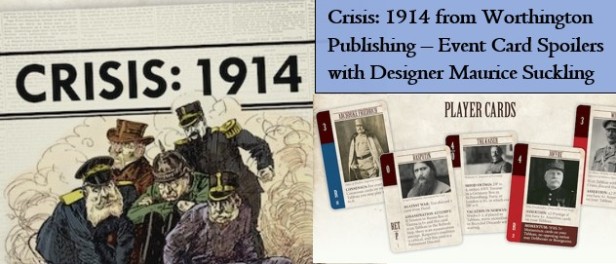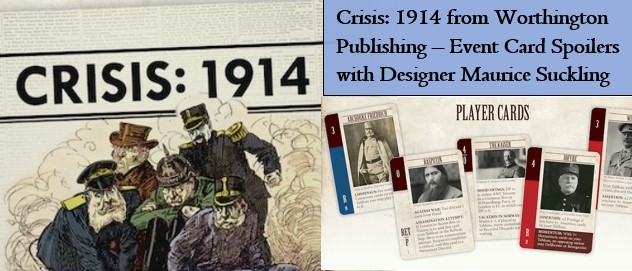We became acquainted with Maurice Suckling with his game Freeman’s Farm 1777 from Worthington Publishing in 2019 and really enjoyed the mechanics and how they all came together to create an interactive and interesting look at the Battle of Saratoga during the American Revolution. Since that time, Maurice has designed several other games that have went on to successful Kickstarter campaigns including Hidden Strike: American Revolution, Chancellorsville 1863 and 1565 Siege of Malta. He is now working on a game that is tied to the buildup of tensions that led to the outbreak of The Great War called Crisis: 1914 from Worthington Publishing, which was successfully funded on Kickstarter this past summer. He has prepared a series of Event Card Spoilers for the game and we are hosting them here on the blog. These posts will share the cards basis in history as well as how they are used in the game.

If you are interested in ordering Crisis: 1914, you can pre-order a copy for $65.00 from the Worthington Publishing website at the following link: https://www.worthingtonpublishing.com/collection/crisis-1914-pre-order-this-game-will-not-ship-until-february-2024

Card #18 – René Viviani – Prime Minister and Foreign Minister
A “highly effective parliamentary politician, but a complete novice in foreign affairs” (Clark 2012, 313). With barely two weeks of experience in his role at the start of the Crisis, and as a result of the general weakness of foreign ministers in France, René Viviani possessed rather limited capacity to influence the direction of French foreign policy on the continent (Clark 2012, 191, 311). As a result, Viviani was largely forced to take a backseat to President Poincaré, especially during their summit in St. Petersburg (Clark 2012, 438, 440, 441, 446); it is quite possible that this was intentional as Viviani’s government was said to be “a caretaker government” pending the outcome of the Madame Caillaux Trial and the return of Joseph Caillaux (McMeekin 2013, 65).

Card #21 – General Joseph Joffre – Chief of the Army Staff
The architect of Plan XVII, which was the name of a “scheme of mobilization and concentration” that was adopted by the French Conseil Supérieur de la Guerre from 1912 to 1914, to be put into effect by the French Army in a war between France and Germany. It was a plan for the mobilization, concentration and deployment of the French armies, to make possible an invasion of either Germany or Belgium or both, before Germany completed the mobilization of its reserves simultaneous with a Russian offensive. Since his appointment as Chief of the Army Staff in 1911, General Joffre had promoted the need for a general offensive mobilization plan – in stark opposition to the existing Plan XVI and its reliance upon a reactive counter-offensive strategy (Martel 2014, 326). He consequently stressed the importance of Russian support against Germany in East Prussia and argued for the expansion of western Russian rail lines to more efficiently move troops; without them, he recognized, France risked facing the full weight of the German military (Martel 2014, 326; McMeekin 2013, 304-305, 306-307).

Card #22 – Madame Caillaux Trial – Politicians focus on the trial of Madame Caillaux
For nine days from July 20-28, 1914, the trial of Madame Henriette Caillaux captivated audiences across France and largely overshadowed the ongoing – and gradually deteriorating – situation in the Balkans (Martel 2014, 135, 160, 210).
Madame Caillaux was the second wife of Joseph Caillaux, Prime Minister of France from June 1911 to January 1912; she was herself previously married to Léo Claretie, a writer for the newspaper Le Temps, and first became involved with Monsieur Caillaux in 1907, roughly a year prior to their divorce. After his own divorce, Joseph married Henriette in October 1911 (Berenson 1992, 13).
It was ultimately their sordid past together that led to the trial some three years later. While the trial explicitly concerned Madame Caillaux’s murder of Gaston Calmette, editor of the right-leaning Le Figaro, her defense hinged on the argument that she had acted in the heat of the moment in defense of her husband and his reputation. Throughout the preceding winter, Calmette had engaged in a “campaign of libel and character assassination” in an effort to undermine Monsieur Caillaux and the left-wing financial policies he actively supported (Berenson 1992, 1). This campaign culminated in Calmette’s publication of old personal correspondence between Monsieur Caillaux and Berthe Gueydan, a married woman who would eventually become his first wife; Henriette feared that the origins of her relationship with Joseph would be similarly revealed if Calmette were allowed to persist (Berenson 1992, 1, 14-15). And so, on the evening of March 16th, she met with Calmette at the newspaper’s office and fired six shots, mortally wounding him. She was seized by members of the newspaper’s staff and arrested on site (Berenson 1992, 2).
The case thus bore all the hallmarks of a sensational story: a powerful politician and his high-society wife, adultery, an apparent journalistic vendetta, and a cold-blooded murder. The trial itself was nearly as scandalous: At one point, a duel between two of the judges seemed likely; later, when a small number of letters between Joseph and Henriette Caillaux were read aloud, the latter fainted and the proceedings were adjourned for nearly an hour (Martel 2014, 210, Berenson 1992, 208-209). The courtroom was consistently filled and on July 28th, the final day of the trial, nearly two thousand spectators packed into the Palais de Justice to await the verdict (Martel 2014, 281).
Madame Caillaux was acquitted.

Card #23 – Plan XVII – The French plan for an offensive against Germany called for the cancellation of leave and the recall of troops from Morocco
Plan XVII was a planned offensive through Alsace and Lorraine. General Joffre devised the plan between 1911 and 1913 after the resignation of his predecessor, Victor-Constant Michel, who had conceived of a (rejected) defensive plan to face potential German moves through the Low Countries (i.e., the Netherlands, Belgium, and Luxembourg). Ted Raicer describes Plan XVII as “less a military blueprint than an exercise in wishful thinking” and notes that “Joffre, in fact, was marching his armies straight into the trap Schlieffen had set for them” (Raicer 2009, 31).

Card #24 – Poincaré In Transit
Accompanied by Prime Minister Viviani and Pierre de Margerie, President Poincaré departed for Dunkirk on the night of July 15. From there (the following day), the trio embarked upon the battleship France and began their voyage to St. Petersburg; they would arrive on July 20th and remain until July 23rd, only returning to Dunkirk on July 29th (Clark 2012, 438, 426, 442-443).
Meanwhile, Berchtold attempted to time the issuance of the ultimatum to ensure that Poincaré would already be en route from St. Petersburg and unable to fully respond to the crisis (Clark 2012, 426). He was to some extent successful: due to the nature of contemporary wireless communication technology and its use at sea, Poincaré was out of step with developments when he arrived back in France (McMeekin 2013, 261-263).
If you missed the previous entries in the series, you can catch up on the posts to date by following the below links:
Series Introduction and General Mobilization Cards
If you are interested, we posted an interview with the designer and you can read that at the following link: https://theplayersaid.com/2023/07/12/interview-with-maurice-suckling-designer-of-crisis-1914-from-worthington-publishing-currently-on-kickstarter/
-Grant

Very interesting! Do you know of this (together with Part 1) comprises all French cards?
I would have been intrigued to see how the game handles Poincaré and his visit to St Petersburg – after all, this was the only time that two great-power governments could talk and plan together in person during the crisis, and Poincaré saw it from the beginning as an opportunity in which he could be sure that the Russians would be firm at France’s side as the source of conflict (Serbia) was in their sphere of influence.
LikeLiked by 1 person
I think that there are more French cards. He was just giving us a taste for each of the factions and their differences.
LikeLiked by 1 person
Consider my appetite whetted!
LikeLiked by 1 person